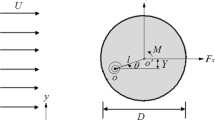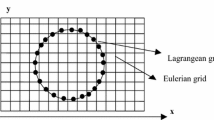Abstract
There are numerous experimental and numerical studies available on the Vortex-Induced Vibration (VIV) for 2D and 3D incompressible flow past bluff bodies (Sen et al in J Fluid Mech 620:89–119, 2009 [1]; Sharma et al in Phys Fluids, 2022 [2]). However, similar analysis is lacking for the case of high-speed compressible flows past bluff bodies. Here, we assess the effect of reduced mass on the unsteady two-dimensional (2D) VIV of the undamped elastically suspended circular cylinder constrained to move in the vertical y-direction only. We perform Direct Numerical Simulation (DNS) by solving the governing Navier–Stokes equation (NSE) by using high-accurate schemes for spatial discretization and time integration. The computational study has been performed for Reynolds number (based on the diameter of the circular cylinder) of \(150\) and free-stream Mach number of \(0.5\) for three cases of reduced mass \(m_{*} = 2m/\rho_{\infty } D^{2} = 1.0, 5.0, {\text{and}} 10,\) where \(m\) and \(\rho_{\infty }\) are the mass of cylinder per unit length and free-stream density of the fluid, respectively. We analyze time-dependent variations in coefficient of lift (\(C_{l}\)), coefficient of drag (\(C_{d}\)), displacement \(y_{CM}\) of the cylinder, and variation of (\(C_{l}\)) with (\(C_{d}\)) for a wide range of the reduced velocity (\(U_{*} = U_{\infty } / f_{N} D\)), to determine its response. Here, \(k_{y}\) and \(f_{N} = 1/2\pi \sqrt {k_{y} /m}\) are the spring constant and the natural frequency of the vibration of the cylinder, respectively. Based on the results plotted, we have noted interesting patterns in the time history of \(C_{l}\), \(C_{d} ,\) and \(y_{CM}\). . For lesser values of the reduced velocity (\(U_{*}\)), presence of multiple modes in the response is noted, while at a higher value of \(U_{*}\), presence of super-harmonics are noted. The maximum amplitude of the response is noted for some intermediate value of the reduced velocity \(U_{*}\). We also plot pressure and vorticity contours for the computed cases for visualization of the vorticity patterns and propagation of resulting acoustic waves due to the influence of compressibility whose details will be explained in the presented article.
Access this chapter
Tax calculation will be finalised at checkout
Purchases are for personal use only
Similar content being viewed by others
References
Sen S, Mittal S, Biswas G (2009) Steady separated flow past a circular cylinder at low Reynolds numbers. J Fluid Mech 620:89–119
Sharma G, Pandey AK, Bhardwaj R (2022) Effect of shape of frontbody and afterbody on flow past a stationary cylinder at Re= 100”. Phys Fluids
Kumar B, Mittal S (2006) Prediction of the critical Reynolds number for flow past a circular cylinder. Comput Methods Appl Mech Eng 195(44–47):6046–6058
Sarpkaya T (2004) A critical review of the intrinsic nature of vortex-induced vibrations. J Fluids Struct 19(4):389–447
Bearman PW (1984) Vortex shedding from oscillating bluff bodies. Annu Rev Fluid Mech 16(1):195–222
Prasanth TK, Mittal S (2008) Vortex-induced vibrations of a circular cylinder at low Reynolds numbers. J Fluid Mech 594:463–491
Singh SP, Mittal S (2005) Vortex-induced oscillations at low Reynolds numbers: hysteresis and vortex-shedding modes. J Fluids Struct 20(8):1085–1104
Varaprasad Patnaik BS, Aswatha Narayana PA, Seetharamu KN (1999) Numerical simulation of vortex shedding past a circular cylinder under the influence of buoyancy. Int J Heat Mass Transf 42(18):3495–3507
Singh SP, Chatterjee D (2014) Impact of transverse shear on vortex induced vibrations of a circular cylinder at low Reynolds numbers. Comput Fluids 93:61–73
Hoffmann KA, Chiang ST (2000) Computational fluid dynamics volume I. In: Engineering education system
Chung TJ et al (2002) Computational fluid dynamics. Cambridge University Press
Sengupta T (2013) High accuracy computing methods: fluid flows and wave phenomena. Cambridge University Press
Jameson A (2017) Origins and further development of the Jameson–Schmidt–Turkel scheme. AIAA J 55(5):1487–1510
Dorogi D, Baranyi L (2020) Identification of upper branch for vortex-induced vibration of a circular cylinder at Re= 300. J Fluids Struct 98:103135
Acknowledgements
The simulations were run on the High-Performance Computer facility (Aryabhatta) at Indian Institute of Technology (Indian School of Mines), Dhanbad. We acknowledge the HPC facility support given by IIT(ISM)—Dhanbad. Also acknowledge the financial assistance provided by Prime Minister Research Fellowship (PMRF) for encouraging research.
Author information
Authors and Affiliations
Corresponding author
Editor information
Editors and Affiliations
Rights and permissions
Copyright information
© 2024 The Author(s), under exclusive license to Springer Nature Singapore Pte Ltd.
About this paper
Cite this paper
Deepak, S.O., Bhardwaj, C.K., Sharma, S., Bhaumik, S. (2024). Effect of Reduced Mass on Two-Dimensional Compressible Flow Past Circular Cylinder. In: Singh, K.M., Dutta, S., Subudhi, S., Singh, N.K. (eds) Fluid Mechanics and Fluid Power, Volume 2. FMFP 2022. Lecture Notes in Mechanical Engineering. Springer, Singapore. https://doi.org/10.1007/978-981-99-5752-1_70
Download citation
DOI: https://doi.org/10.1007/978-981-99-5752-1_70
Published:
Publisher Name: Springer, Singapore
Print ISBN: 978-981-99-5751-4
Online ISBN: 978-981-99-5752-1
eBook Packages: EngineeringEngineering (R0)




